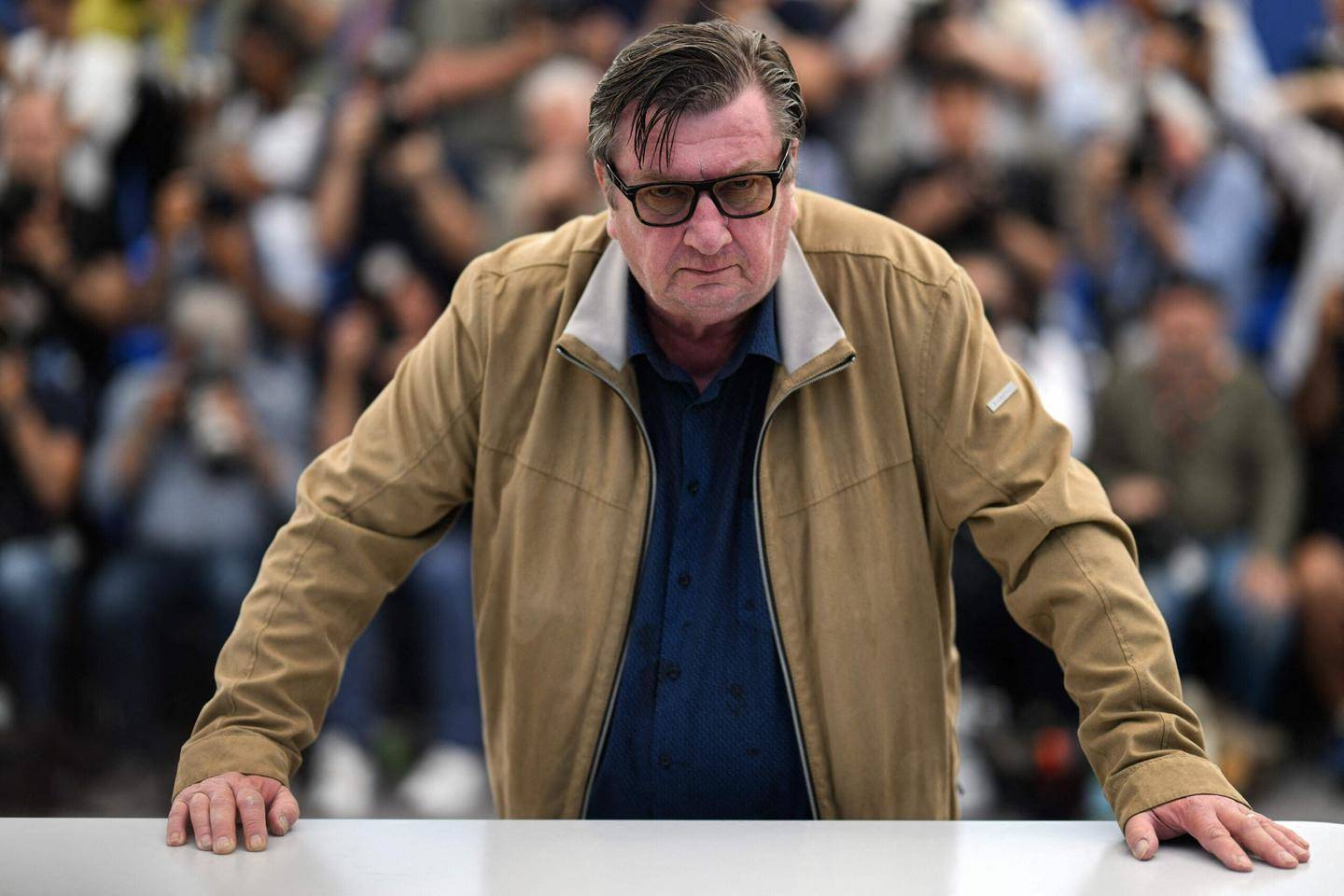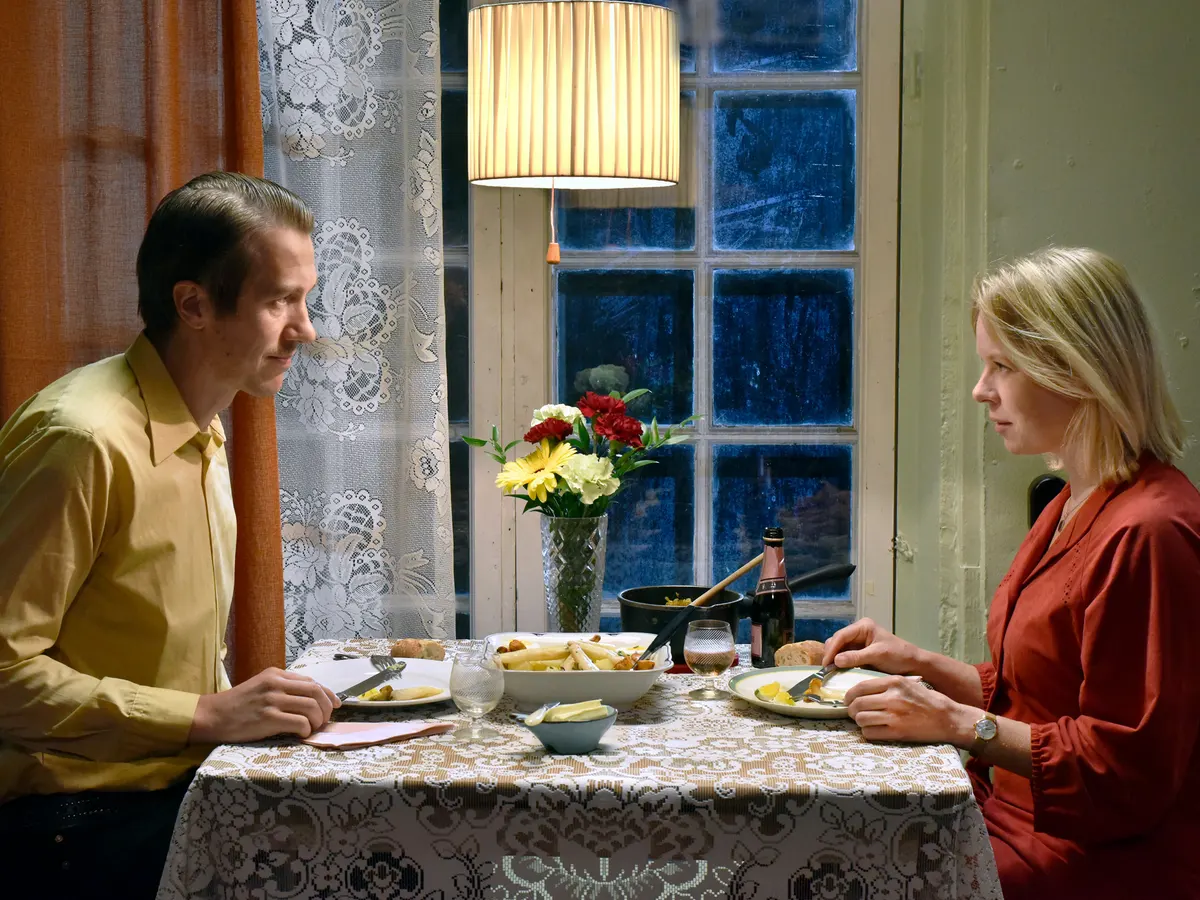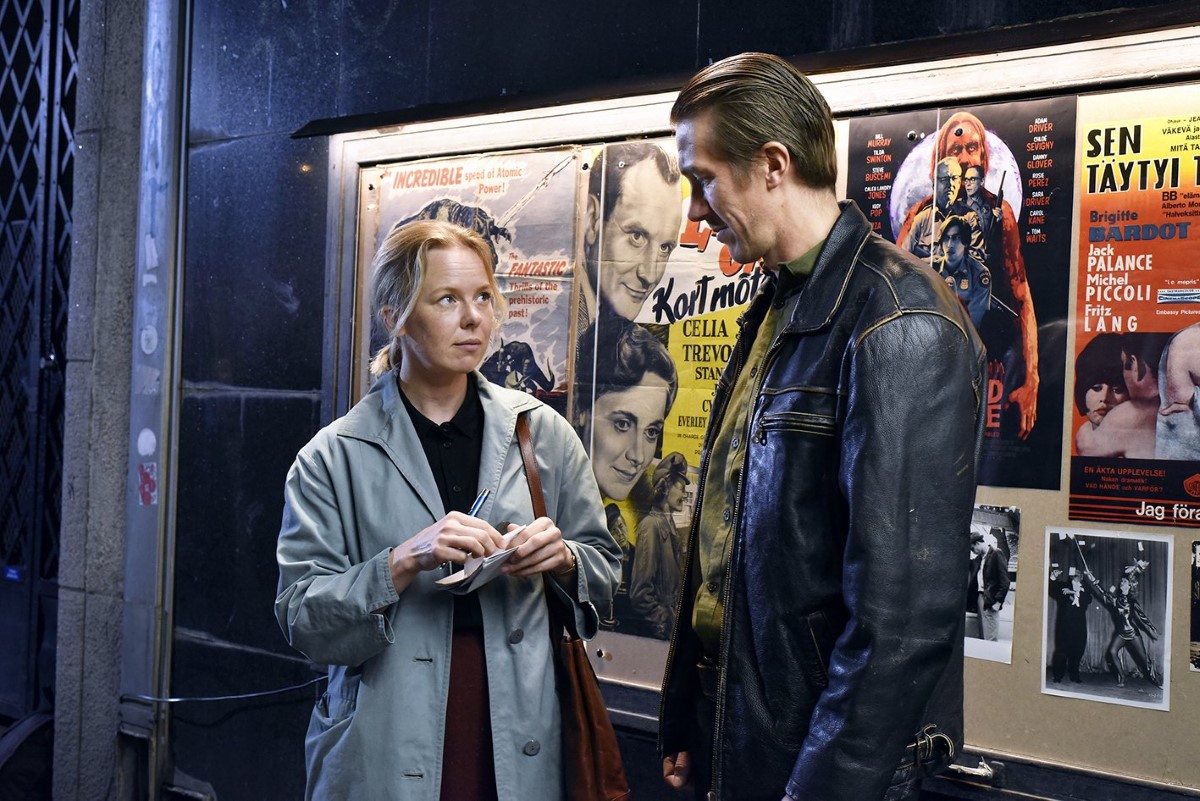by Mariuccia Ciotta
Perched in a row against a wall in a dance hall, with karaoke in full swing, or standing, leaning against the entrance of a small suburban cinema, they smoke. Or, motionless, petrified, around a table facing bottles of Finnish vodka, Kossu schnapps. Their eyes fixed elsewhere, unblinking. The characters in Aki Kaurismäki’s films exist in an imaginary waiting room. The empty restaurant in Drifting Clouds or the mesmerizing display of wrenches in Tatjana. Like their beloved Beckett, they wait.
Frost, darkness, poverty in a Finland not of today but an abstract, anachronistic landscape. “The 70s have been much ridiculed, but they were a period of passion, far more than today’s post-imperialist digital era.” The Finland of Aki’s times, having cycled through some forty odd jobs, from construction worker to warehouseman, from dishwasher to painter and journalist, before turning to filmmaking: “Maybe I thought of doing cinema because I’m incapable of honest work.” Yet, they are honest, his protagonists, battling petty bosses and exploiters, in the slightly tattered clothes of garbage collectors, miners, drivers, refugees, cashiers, factory workers, waiters, inhabitants of a (sub)proletarian world, on the fringes, superfluous but with the cultural dignity of an exclusive club. Furious inside, but never agitated, “a mere arching of the eyebrows can express all the suffering in the world.” Or an uncontrollable rage. Cigarettes stuck in mouths, coffee and beer flowing endlessly. “A man, a cigarette, and a nostalgic look. At least that, I think I can master.”
Minimalism, the cinema of subtraction. Nonexistent scripts, “written” dialogues, literary, the opposite of more realistic spoken language. The clash between reality and fairy-tale madness in his cinema is always fierce.
The Helsinki fog clears in Fallen Leaves (Jury Prize at Cannes 2023) but in the original title (Kuolleet lehdet), the leaves are dead, an autumn carpet for a Chaplinesque ending, capable of reviving if only love arrives and overturns the shots of alcohol. And sobers up the “drunken hobo”. The same life-giving effect of flowers given to a woman on her deathbed in Le Havre, an antidote to a tragic ending, which concludes half of Kaurismäki’s works. The other half achieve a happy ending. Thus, Holappa, a repeatedly fired worker, offers that bouquet to his beloved Ansa, fired (also) from the supermarket for keeping an expired doughnut, destined for the trash. A freeze-frame of Peynet’s lovers in a silent scenario, where it’s better to subtract the voice and let the image speak, or perhaps not even that. Cinema sends innocence into battle against cynicism, says Kaurismäki, who still believes in what has never happened, communism. And sees his Finland sinking into indifference.
In Fallen Leaves, Alma Pöysti (Ansa) is the spitting image of the cult actress Kati Outinen, while Jussi Vatanen has taken the place of the late Matti Pellonpää. The personalities, however, are the same, in tune with the working-class trilogy: Shadows in Paradise (1986), Ariel (1988), and The Match Factory Girl (1990), where memories of Hans Christian Andersen surface and the beginning is like a documentary in a factory, a challenge to action cinema because the plot can also be born from a matchstick. Or following the example of Jean Painlevé’s scientific-poetic documentaries.
A cinema that is rarefied, poignant, elliptical, surreal thinking of Bresson and Buñuel, his favorite masters, along with Godard, Jarmusch, Bresson, Truffaut, Ozu, Huston. There are about a hundred allusions or references to beloved films that Aki scatters among the frames. Cinema full of black humor and rock-pop dissonances, Shostakovich/Tchaikovsky/Haydn, as taught by the saga of the Leningrad Cowboys, with banana hair and pointy shoes. There’s also the shadow of Bergman, if only because he bought his first camera from him. And the ghost of Ouedraogo, with his figures outlined against the desert. Kaurismäki has another self that resembles him, Jean-Pierre Léaud, actor in two films, I Hired a Contract Killer (1990) and Le Havre (2021), a poem with the young migrant from Gabon, Idrissa (Ouedraogo!), hidden from inspector Monet, a tribute to Marcel Carné, and starring a bohemian shoe-shiner who goes by the name Marx, and we’re not talking about Groucho.
Aki’s world is blue in the photography of his faithful Timo Salminen, a world made of lights and shadows, evanescent like the clouds and at the same time hard and seeking justice. His antiheroes are rooted to the ground, their gaze direct, only apparently absent, ready to strike. The recurring dream of a place where one feels free, “which is only the movie theater,” the wait is there. In the antechamber of paradise, equipped with a bar on the left, first drink free. Aki hasn’t seen paradise yet, “but at least I know that the bar is right behind me.”
Essential Filmography
by Roberto Silvestri
ARIEL [1988]
Taisto, in trouble, flees to Mexico on the cargo Ariel and works as a dockworker. A suicidal friend leaves him a Cadillac. Even though robbed, Taisto ends up in jail, but his lover, a female police officer, helps him escape. After robbing a bank, they sail away with Ariel. When absurd misfortune meets boundless compassion, revolutionary humor is born, elevated by Aki to an art form.
LENINGRAD COWBOYS GO AMERICA [1989]
From the tundra to Mexico, across the USA in a Cadillac, with the bassist’s coffin on the roof. A demented road movie of a Finnish rock band, with unicorn hair and protruding shoes, going where “they swallow any crap.” The bassist, frozen to death, is resurrected by sun, tequila, and chili. Featuring Jarmusch.
THE MATCH FACTORY GIRL [1990]
More desperate proletarians, very few dialogues, the process of stripping down the image pushed to the extreme. Iris works in a match factory and one evening at a dance meets a seducer, believes it’s true love, but he impregnates her and leaves her. Iris first aborts and then kills the man with rat poison.
I HIRED A CONTRACT KILLER [1990]
London. Henry (Léaud), fired and desperate, hires a killer to assassinate him, but falls in love with Margaret that same night. The killer persists, but later, finding out he has incurable cancer, commits suicide. Fixed camera, long takes, no unnecessary tricks or dialogues. Only what is essential is shown. Ozu meets Godard.
TAKE CARE OF YOUR SCARF, TATJANA [1994]
An on-the-road essay on the Finnish male, and last film together with Matti Pellonpää. Watch out for the scarf, Tatjana, the original title, refers to a 60s motorcycle accessory. The taciturn Valdo and the rocket-riding, alcoholic mechanic Reino pick up Belarusian Klavdia and Estonian Tatjana. And all four drive to Estonia.
DRIFTING CLOUDS [1996]
A husband and wife, both laid off, open a traditional restaurant in Helsinki, rehiring the staff of the prestigious Dubrovnik, devoured by banks. Overcoming various difficulties, good food and attention to classy details win. A tribute to Frank Capra. The great critic Peter von Bagh orders a bottle of “Koskenkorva”.
JUHA [1999]
Juha, a crippled and ugly lumberjack, loses Marja, seduced by the womanizer Shemeikka, but finds her again. A melodrama set between the wooded Karelia and Russia, silent with music, a tribute to Murnau (about a hundred references): “Mine is the communist version of the Finnish classic by Juhani Aho, Mauritz Stiller did the social democratic version in 1921.”
THE MAN WITHOUT A PAST [2002]
Brutally attacked in Helsinki, a man loses his memory and lives among containers and hobos. He meets Irma and a tender bond forms. After regaining his memory and finding his true wife, he returns to Irma. Very few dialogues: “I aim for a narration as pure as possible, close to the essential quality of cinema, purity.”
LE HAVRE [2011]
A shoeshiner, former writer, with his seriously ill wife, hides Idrissa, a young African boy who immigrated to the French port of Le Havre and is trying to reach his mother in London. The whole neighborhood and an honest policeman help him. Kaurismäki’s second French film after La Vie de Bohème, produced by his Sputnik.
THE OTHER SIDE OF HOPE [2017]
A Helsinki shirt salesman argues with his wife, leher, wins at poker, and opens a restaurant, hiring an undocumented Syrian refugee searching for his sister, lost crossing the EU-Balkan border. He finds her in Lithuania.
FilmTV, Issue 51, December 19, 2023
* * *
ORIGINAL ITALIAN ARTICLE:
I film di Aki Kaurismäki, fra comicità laconica e umanesimo struggente
di Mariuccia Ciotta
Seduti in fila contro un muro nella sala da ballo, karaoke a go-go, oppure in piedi appoggiati all’ingresso di un cinemino di periferia, fumano. O ancora immobili, pietrificati, intorno a un tavolino di fronte a bottiglie di vodka finlandese, l’acquavite Kossu. Gli occhi puntati altrove, fìssi. I personaggi di Aki Kaurismäki vivono in un’immaginaria sala d’aspetto. Il ristorante vuoto di Nuvole in viaggio o la vetrina di chiavi inglesi, attrazione estatica, di Tatjana. Come l’amato Beckett, aspettano.
Gelo, buio, miseria in una Finlandia che non è quella di oggi, ma un paesaggio astratto e anacronistico. «Si è fatta molto ironia sugli anni 70, ma è stato un periodo pieno di passione, molto più dell’era digitale post-imperialista di oggi». La Finlandia dei tempi di Aki, passato per una quarantina di mestieri diversi, da muratore a operaio, da magazziniere a lavapiatti, imbianchino e giornalista, prima di arrivare alla regia: «Forse ho pensato di fare cinema perché non sono capace di fare un lavoro onesto». Eppure lo sono, onesti, i suoi protagonisti, in lotta contro padroncini e sfruttatori, nelle vesti un po’ stracciate di netturbini, minatori, autisti, profughi, cassiere, operaie, camerieri, abitanti di un mondo (sotto)proletario, ai margini, superfluo ma che ha la dignità culturale di un club esclusivo. Gente furiosa dentro ma che non si agita mai, «un semplice inarcamento delle sopracciglia può esprimere tutta la sofferenza del mondo». O anche una rabbia incontenibile. Sigarette piantate in bocca, caffè e birra a fiumi. «Un uomo, una sigaretta e uno sguardo nostalgico. Almeno questo credo di riuscire a padroneggiarlo».
Minimalismo, cinema del sottrarre. Sceneggiature inesistenti, dialoghi “scritti”, letterari, all’opposto del più realistico linguaggio parlato. Lo scontro tra realtà e follia fiabesca nel suo cinema è sempre furioso.
La nebbia di Helsinki si dirada in Foglie al vento (Premio della giuria a Cannes 2023) ma nel titolo originale (Kuolleet lehdet) le foglie sono morte, tappeto autunnale di un finale chapliniano, capaci di resuscitare se solo l’amore arriva e rovescia i bicchierini di alcol. E rende sobrio il “barbone alcolizzato”. Stesso effetto vitale dei fiori offerti a una donna in fin di vita di Miracolo a Le Havre, antidoto a una conclusione tragica, che chiude metà delle opere di Kaurismäki. L’altra metà conquista l’happy end. Così Holappa, operaio pluri-licenziato, porge quel mazzolino all’amata Ansa, licenziata (anche lei) dal supermercato per aver conservato una ciambella scaduta, destinata alla spazzatura. Fermoimmagine dei fidanzatini di Peynet in uno scenario muto, dove è meglio sottrarre la voce e lasciar parlare l’immagine, o forse neanche quella. Il cinema manda in campo l’innocenza a combattere il cinismo, dice Kaurismäki, che crede ancora in ciò che non è mai accaduto, il comunismo. E vede la sua Finlandia sprofondare nell’indifferenza.
In Foglie al vento, Alma Pöysti (Ansa) è la fotocopia dell’attrice cult Kati Outinen, mentre lui, Jussi Vatanen, ha preso il posto dello scomparso Matti Pellonpää. Le personalità, però, sono le stesse, in sintonia con la trilogia operaia: Ombre in paradiso (1986), Ariel (1988) e La fiammiferaia (1990), dove spuntano memorie di Hans Christian Andersen e l’incipit è una specie di documentario in fabbrica, una sfida al cinema d’azione perché la trama può nascere anche da un fiammifero. O seguendo l’esempio dei doc scientifico-poetici di Jean Painlevé.
Cinema rarefatto, struggente, ellittico, surreale pensando a Bresson e a Buñuel, i maestri preferiti, insieme a Godard, per non parlare di Jarmusch, Bresson, Truffaut, Ozu, Huston. Sono un centinaio le allusioni o le citazioni di film amati che Aki sparge tra i fotogrammi. Cinema pieno di humour nero e di dissonanze rock pop, Shostakovich/Tchaikovsky/Haydn, come insegna la saga dei Leningrad Cowboys, con i capelli a banana e le scarpe puntute. C’è anche l’ombra di Bergman, se non altro perché la macchina da presa dei primi lavori l’ha comprata da lui. E il fantasma di Ouedraogo, con le sue figurine stagliate nel deserto. Kaurismäki ha un altro da sé che gli assomiglia, Jean-Pierre Léaud, attore in due film, Ho affittato un killer (1990) e Miracolo a Le Havre (2021), poemetto con il piccolo migrante del Gabon, Idrissa (Ouedraogo!), nascosto all’ispettore Monet, omaggio a Marcel Carnè, e con protagonista uno scrittore bohémien-lustrascarpe che fa di cognome Marx, e non parliamo di Groucho.
Il mondo di Aki è blu nella fotografìa del fedelissimo Timo Salminen, un mondo fatto di luci e di ombre, evanescente come le nuvole e al tempo stesso duro e in cerca di giustizia. I suoi antieroi sono piantati in terra, sguardo frontale, solo all’apparenza assente, pronti a colpire. Sogno ricorrente di un luogo dove sentirsi liberi, «che è solo la sala cinematografica», l’attesa è lì. Nell’anticamera del paradiso, dotato di un bar sulla sinistra, prima bevuta gratis. Aki non l’ha ancora visto il paradiso, «ma almeno so che il bar è subito là dietro di me».
* * *
Filmografia essenziale
di Roberto Silvestri
ARIEL [1988]
Taisto, nei guai, fugge in Messico sul cargo Ariel e fa il portuale. Un amico suicida gli lascia la Cadillac. Pur rapinato, Taisto finisce dentro, ma l’amante vigilessa lo fa evadere. Svaligiata una banca, salpa con l’Ariel. Quando un’assurda sfortuna incrocia una sconfinata compassione nasce l’umorismo rivoluzionario che Aki eleva a forma d’arte.
LENINGRAD COWBOYS GO AMERICA [1989]
Dalla tundra in Messico, attraverso gli Usa in Cadillac, con la bara del bassista sul tetto. Road movie demenziale di una rock band finnica, dai capelli a unicorno e scarpe protuberanti che va lì dove «mandano giù ogni stronzata». Il bassista, morto assiderato, resuscita tra sole, tequila e chili. C’è Jarmusch. Primo Kaurismäki che esce in Italia.
LA FIAMMIFERAIA [1990]
Ancora proletari disperati, pochissimi dialoghi, il processo di scarnificazione dell’immagine spinto fino all’estremo. Iris lavora in una fabbrica di fiammiferi e una sera a un ballo incontra un seduttore, crede sia un vero amore, ma lui la mette incinta e l’abbandona. Iris prima abortisce e poi uccide l’uomo con il veleno per topi.
HO AFFITTATO UN KILLER [1990]
Londra. Henry (Léaud), licenziato e disperato, assolda un killer perché l’uccida, ma la notte stessa s’innamora di Margaret. Il killer non demorde, poi però, scoperto di avere un cancro incurabile, si suicida. Macchina fissa, pianisequenza, nessun trucco né dialogo di troppo. Si vede solo ciò che serve. Ozu incontra Godard.
TATJANA [1994]
Saggio on the road sul maschio finlandese, e ultimo film insieme a Matti Pellonpää. Attenta al foulard, Tatjana, il titolo originale, riguarda l’accessorio anni 60 utile in moto. Il taciturno Valdo e il meccanico rockettaro e alcolizzato Reino rimorchiano la bielorussa Klavdia e l’estone Tatjana. E tutti e quattro vanno in auto in Estonia.
NUVOLE IN VIAGGIO [1996]
Marito e moglie, licenziati, aprono a Helsinki un ristorante, locale all’antica, riassumendo lo staff del prestigioso Dubrovnik, divorato dalle banche. Superate difficoltà d’ogni tipo, il buon cibo e l’amore per il dettaglio di classe vincono. Omaggio a Frank Capra. Il grande critico Peter von Bagh ordina la bottiglia di “Koskenkorva”.
JUHA [1999]
Juha, taglialegna storpio e brutto, perde Marja, sedotta dal donnaiolo Shemeikka, ma la ritroverà. Mèlo ambientato tra la boscosa Carelia e la Russia, muto con musica, in omaggio a Murnau (un centinaio le citazioni): «La mia è la versione comunista del classico finnico di Juhani Aho, Mauritz Stiller nel 1921 fece quella socialdemocratica».
L’UOMO SENZA PASSATO [2002]
Aggredito selvaggiamente a Helsinki, un uomo perde la memoria e vive tra container e barboni. Conosce Irma e tra loro nasce un tenero legame. Ritrovata la memoria e la vera moglie, tornerà da Irma. Pochissimi dialoghi: «Tendo a una narrazione che sia il più possibile pura, vicina alla qualità essenziale del cinema, la purezza».
MIRACOLO A LE HAVRE [2011]
Un lustrascarpe, ex scrittore, con la moglie gravemente malata, nasconde in casa Idrissa, un ragazzino africano immigrato nel porto francese di Le Havre che cerca di raggiungere la madre a Londra. Tutto il guartiere e un poliziotto onesto l’aiuteranno. Secondo film in francese di Kaurismäki dopo Vita da bohème, produce la sua Sputnik.
L’ALTRO VOLTO DELLA SPERANZA [2017]
Un commerciante di camicie di Helsinki litiga con la moglie, la lascia, vince a poker e apre un ristorante assumendo in nero un profugo siriano in cerca della sorella, dispersa attraversando la frontiera tra Unione Europea e Balcani. La rintraccia in Lituania. Il proprietario del ristorante aiuterà fratello e sorella a ricongiungersi.
FilmTV, n. 51, 19 dicembre 2023




